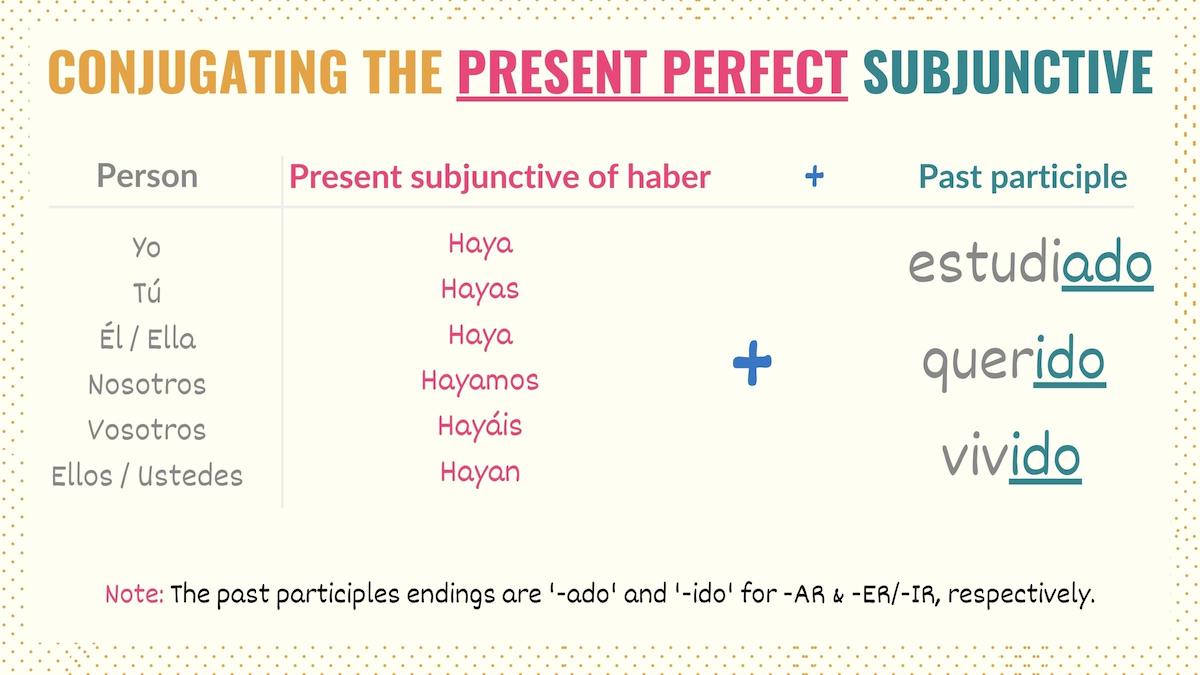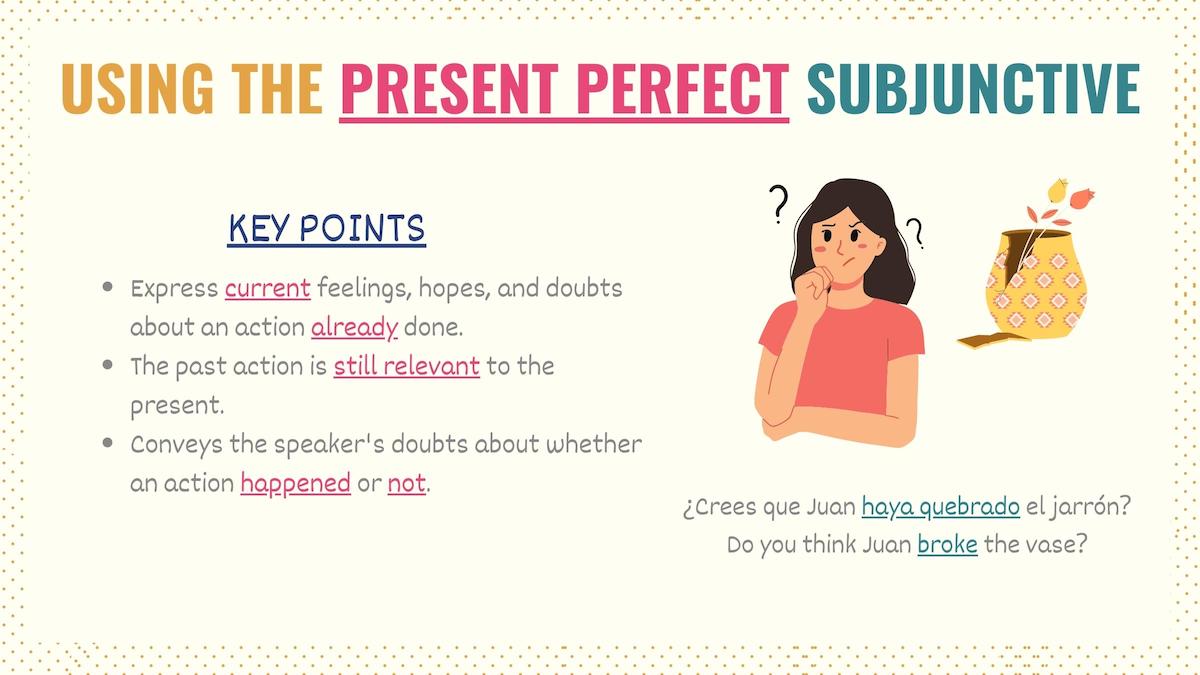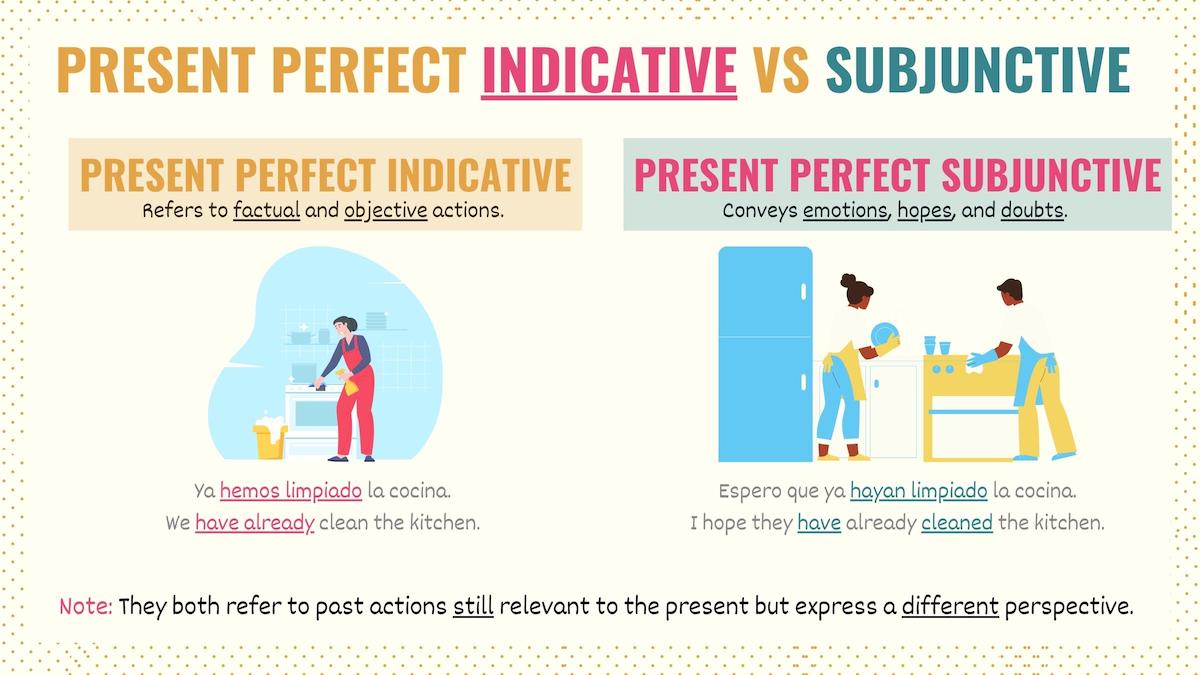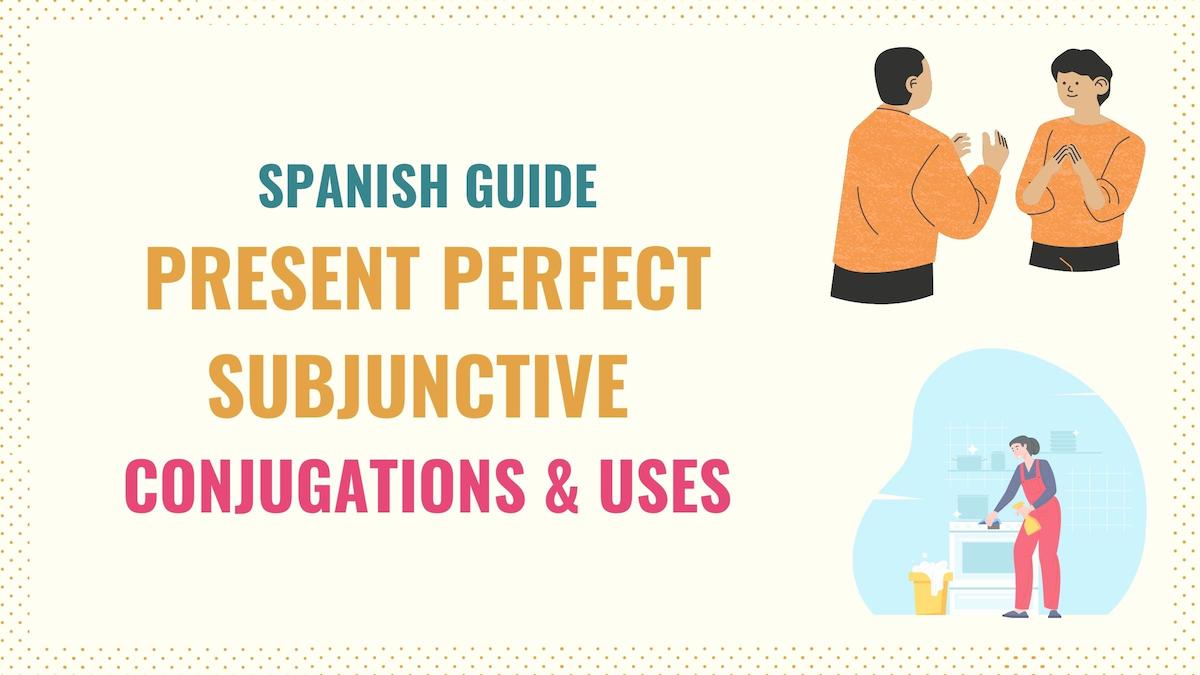Like the present indicative, the present subjunctive also has a compound form – the present perfect subjunctive Spanish tense. This subjunctive form is particularly useful for expressing emotions or doubts about past actions.
The Spanish present subjunctive can enhance your proficiency and make your conversations more precise and nuanced. So, in this guide, you’ll find all the key information you need to master this tense:
- How to Form the Present Perfect Subjunctive
- Uses of the Spanish Present Perfect Subjunctive
- Present Perfect Indicative vs Present Subjunctive
- Key Points
- Practice Quiz
- Next Steps
How to Conjugate the Present Perfect Subjunctive in Spanish
The conjugation of the Spanish present perfect subjunctive requires two elements:
1. Haber’s present subjunctive forms
2. A verb in past participle form
Let’s start with the first element.
The present subjunctive of haber is formed by adding the subjunctive endings for -ER verbs to the irregular stem hay. Here is a conjugation chart:
| Person | Present Subjunctive |
|---|---|
| Yo | Haya |
| Tú | Hayas |
| Él / Ella Usted | Haya |
| Nosotros | Hayamos |
| Vosotros | Hayáis |
| Ellos / Ellas Ustedes | Hayan |
Regular Spanish past participles are formed by adding the endings –ado and –ido to the stem of -AR and -ER/-IR verbs. For example:
- Ayudar: Ayudado
- Decidir: Decidido
- Tener: Tenido
Be aware that there are some verbs with irregular past participle forms (such as decir, hacer, abrir, escribir, etc). These verbs are considered irregular in the Spanish present perfect subjunctive tense.
So, here are some examples of how these two elements work together:
Espero que hayas ayudado a tu mamá.
I hope you have helped your mom.
Ojalá haya encontrado sus llaves.
I hope you found your keys.
Dudo que hayan comprado lo que les pedí.
I doubt you guys have bought what I asked you.

The following sections will explore when and how to use this subjunctive tense.
Take Note: Spanish auxiliary verbs are responsible for communicating the time and mood of an action, and who performs it.
When to Use the Spanish Present Subjunctive
The Spanish present perfect tenses express current emotions, wishes, and uncertainty about past actions that are still relevant to the present. Simply put, this tense captures someone’s emotional or subjective perspective on actions someone has already done.
Because it conveys your present feelings, doubts, or hopes, this tense works with the present indicative tense to form sentences:
[Present] + que + [present perfect subjunctive]
¿Quién crees que haya quebrado el vaso?
Who do you think broke the glass?
Dudo que hayan terminado de limpiar.
I doubt they have finished cleaning.
Espero que hayas tenido un buen día.
I hope you had a good day.
Let’s analyze example #1. From this sentence, we can infer that the glass was already broken by the time I found it (now). So, I use the present perfect subjunctive to express uncertainty about who did this.

Take Note: Sentences with this tense require a main and dependent clause. In Spanish, the main clause delivers the speaker’s current perception or emotions. The subordinate refers to the action that has already happened and goes in the present perfect subjunctive.
Verbs & Terms that trigger the present perfect subjunctive
Like other subjunctive forms, the present perfect subjunctive tense is triggered by verbs and expressions that convey feelings, hopes, and uncertainty.
Here is a list of common verbs and expressions that trigger this tense:
- A menos que: Unless
- Alegrar que*: To be glad that / To be happy that
- Creer que*: To think that
- Dar miedo que: To be afraid that
- Dar tristeza que*: To be sad that
- Dudar que: To doubt that
- Es bueno que: It’s good that
- Es increíble que: It’s amazing that
- Es posible que: It’s possible that
- Es una lástima que: It’s a shame that
- Esperar que: I hope that
- Estar orgullosa de que: To be proud that
- Extrañar que*: To find odd that
- Gustar que*: To like that
- Más vale que: It would be better that
- Molestar que*: To bother that
- Ojalá: I hope / Hopefully
- ¡Qué + sust/adj + que!: What a / It’s such a + noun/adj + que
- Sentir que: To be sorry that
- Sorprenderse que: To be surprised that
- Tener miedo de que. To be afraid that
A couple of notes to keep in mind:
- All of the verbs in this list must be conjugated in the present indicative tense.
- When working with the present perfect subjunctive, creer que is only used to ask questions or in negative statements.
- The verbs alegrar, molestar, dar, gustar and extrañar must be preceded by indirect object pronouns.
Here are some sentences using these expressions and the present perfect subjunctive tense:
Ojalá hayan llegado bien.
I hope they have arrived well.
¡Qué lástima que no haya funcionado!
What a shame that it didn’t work!
No vamos a ir a menos que hayas limpiado tu cuarto.
We’re not going unless you have cleaned your room.
Take Note: Que is a Spanish conjunction and is used to connect the main clause with the subordinate.
Spanish Present Perfect Indicative vs Present Perfect Subjunctive Tense
The present perfect indicative and its subjunctive counterpart need to be clarified because, on top of having similar names and using similar elements, they both refer to past actions connected to the present. However, there is a substantial difference between these tenses.
The actions described by the Spanish present perfect indicative are considered factual or objective. For example:
Henry ha vivido en Francia toda su vida.
Henry has lived in France his entire life.
Whereas the present perfect subjunctive expresses doubts on whether the action actually happened or conveys the speaker’s emotions towards it:
No creo que Henry haya vivido en Francia toda su vida.
I doubt that Henry has lived in France his entire life.
As you can see, using either the indicative or subjunctive affects how the sentence is perceived.

Take Note: Remember that for the present perfect indicative, you must use the present indicative forms of haber.
Key Points
Although the subjunctive mood may not be as clear and distinct in English, it’s crucial in Spanish. The present perfect subjunctive is an excellent example of this. Here are some key points to remember:
- ‘Haber in the present subjunctive + past participle’ is the formula to create the present perfect subjunctive.
- Irregular verbs in this tense are verbs with an irregular past participle form.
- The Spanish present perfect subjunctive expresses our current feelings, doubts, or hopes about an action that has already happened.
- Spanish verbs that express wishes, doubts or feelings toward something, trigger the subjunctive.
Practice Quiz
I’ve prepared a multiple-choice quiz to ensure you understand how this tense works. Click the button below to take it.
Present Perfect Subjunctive Spanish Additional Resources
There are a couple resources that can help you get more familiar with this Spanish tense. Since they’re crucial elements, make sure you practice the conjugations of haber and check the rules to form past participles in Spanish.
Also, understanding how the present perfect indicative tense works can help you reinforce the uses of the subjunctive form we just learned. Don’t forget to test your knowledge of these two compound tenses by taking this present perfect subjunctive practice quiz.
Finally, study other subjunctive tenses that will help you to better communicate your messages.
Download the Spanish Present Perfect Subjunctive PDF
Feel free to download a copy of the PDF for this guide containing all the graphics and key points for forming and using the Spanish present perfect subjunctive tense.



